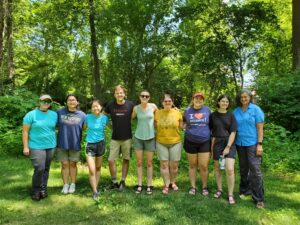On Thursday, June 30th, the entire ALLARM summer team, including full-time staff members Julie Vastine (Director), Stephanie Letourneau (Community Science Specialist), and Phoebe Galione (Outreach Manager), as well as watershed coordinators Grace Messimer (’23), Michelle Hom (’24), Michelle Cao (’25), Charlotte Kratovil-Lavelle (’24), and myself, visited an active stream restoration site at Stuart Park. The goal of this visit was to test a new protocol for assessing stream restoration projects. We were joined by Lori Glace, the Watershed Specialist for Cumberland County, as well as Kristen Saacke Blunk, a contractor working for the National Fish and Wildlife Foundation (NFWF).
Before arriving, we reviewed the restoration plans which included the installation of in-stream structures that would not only stabilize over 800 feet of eroding stream bank, but additionally provide new fish habitat. Invasive plants along the banks would be cut down, making room for more native species to naturally take their place or be planted. This primer was essential for when Lori Glace walked us down the reach of the Yellow Breeches Creek we would be assessing, pointing out where high erosion areas were and where structures would be placed to prevent further loss.
After this walkthrough, we were ready to step into the stream. The restoration assessment protocol we were testing is unique in that previously, no other protocol looked to assess the long-term success of restoration projects from before, to years after installation. This new assessment, while still in the works, includes an extensive datasheet developed by ALLARM, which encompasses measurements like channel geology, geometry, and biological habitats throughout the reach.
This protocol test was my first opportunity to do field work with ALLARM, and I was excited to hop in the stream to take measurements after a semester of being abroad. I got to wear chest waders, which kept me dry as I recorded the geological makeup of the stream bed and banks. Because the work completed on the protocol thus far had not been field tested, running through the entirety of the draft was a fantastic opportunity to test out the clarity and accuracy of the steps, and it allowed Julie and the full-time staff to discover any flaws or wording issues with the datasheets. Measuring the angle of the streambank and the quality of the riparian buffer were two parts of the protocol that we decided needed more clarification.
As someone who has focused mostly on volunteer engagement and research for ALLARM up to this point, having a chance to do field work was such a great opportunity for new experiences. It was exciting to learn about stream health and indicators at the stream itself rather than learning it from videos or in preparation for volunteer events. Additionally, Lori educating us on the different stages of restoration projects was informative and personally interesting, as environmental policy and protection are areas that I am hoping to pursue after I finish my degree at Dickinson College. Overall, a fantastic day with the full ALLARM team!

